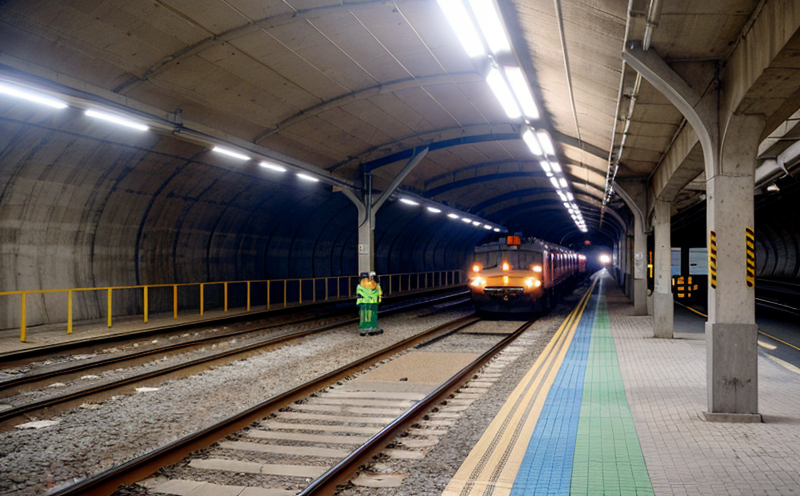EN 50122 Stray Current Testing in Tunnel and Station Systems
The European standard EN 50122-7 defines requirements for the reduction of stray current in railway systems. Stray currents, often referred to as parasitic currents, can cause significant issues within tunnel and station environments, including corrosion of metallic structures, interference with electronic equipment, and safety risks.
The testing method outlined in EN 50122-7 is designed to ensure that stray current levels are minimized or eliminated. This service involves a comprehensive evaluation process aimed at identifying the presence and extent of stray currents within tunnel and station systems. The test aims to comply with international standards and ensure compliance with relevant regulations.
The testing procedure typically begins with an initial survey to identify potential sources of stray current. This can include cables, electrified structures, and metallic parts in close proximity to the railway system. Once identified, a series of tests are conducted using specialized equipment to measure the magnitude and distribution of these currents. The test setup involves placing probes at strategic locations within the tunnel or station to capture stray current data.
The testing process is highly technical and requires precise instrumentation capable of accurately measuring even minute levels of stray current. It includes both stationary and mobile measurements, ensuring a thorough assessment of all relevant areas. After collecting data, it undergoes rigorous analysis to determine compliance with the specified limits as defined in EN 50122-7.
The results of the testing are meticulously documented, providing detailed reports that outline current levels, potential sources, and recommendations for mitigation strategies. This information is crucial not only for regulatory compliance but also for ensuring the longevity and safety of railway infrastructure.
Industry Applications
- Tunnel construction and maintenance
- Station electrification projects
- Railway system upgrades involving new installations
- Preventive maintenance programs for existing infrastructure
The testing process is critical in these applications as it helps identify issues early, preventing costly repairs and ensuring the safety of personnel and equipment.
Why It Matters
The importance of stray current testing cannot be overstated. Stray currents can lead to significant damage to railway infrastructure, including the corrosion of steel structures and track components. This not only increases maintenance costs but also poses a safety risk to personnel working in close proximity.
In addition to structural integrity concerns, stray currents can interfere with electronic equipment, leading to malfunctions or complete failure of critical systems such as signaling and communication networks. Ensuring compliance with EN 50122-7 is essential for maintaining the reliability and safety of railway operations.
The testing process itself is vital in identifying problem areas within tunnel and station environments, allowing for targeted interventions to mitigate stray current issues. This proactive approach helps extend the lifespan of infrastructure and reduces the risk of unforeseen failures that could disrupt service.
Industry Applications
- Tunnel construction and maintenance
- Station electrification projects
- Railway system upgrades involving new installations
- Preventive maintenance programs for existing infrastructure
The testing process is critical in these applications as it helps identify issues early, preventing costly repairs and ensuring the safety of personnel and equipment.
Customer Impact and Satisfaction
- Ensures compliance with international standards for stray current control
- Reduces maintenance costs by identifying issues early
- Enhances safety of personnel working in close proximity to railway systems
- Avoids interference with electronic equipment, ensuring reliable system performance





